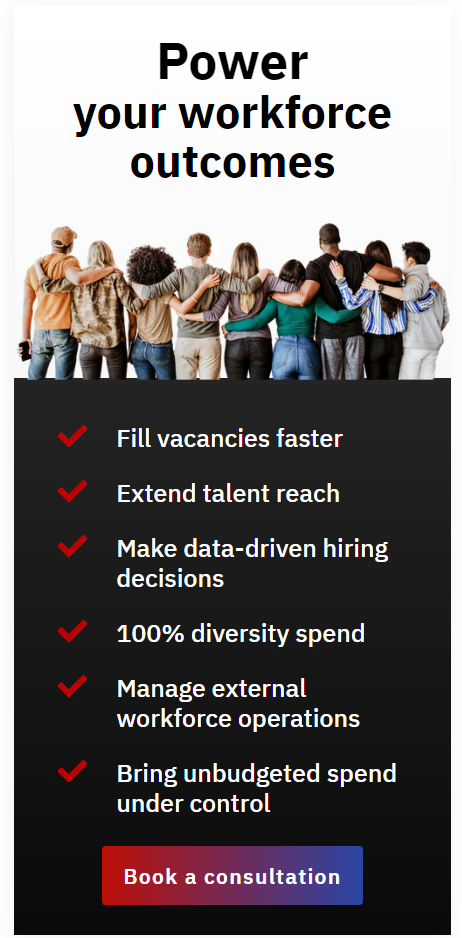
Chloe Mumford - 6 min read
Identifying your neurodivergent workforce quotient
A neurodiverse workforce quotient helps organizations determine the percentage of their workforce that is neurodivergent.
What is a neurodiverse workforce quotient?
Calculating diversity quotients helps gain an understanding of how diverse an organization is. Once you get a figure, you can foster vital conversations and changes in your organization about establishing hiring goals and improving programs.
Furthermore, promoting conversation on neurodiversity helps your workers feel encouraged to open up about their own barriers.
What is neurodiversity?
Neurodiversity is a term that refers to the diversity of human brains and minds, the infinite variation in neurocognitive functioning within our species.
When thinking about neurodiversity, it’s important to understand that there is no ‘right’ way of thinking or learning. By that same logic, you shouldn’t expect one neurodivergent person to be the same as the other, even if they have the same neurological condition. Multiple neurological or developmental conditions are understood in the category of ‘neurodiversity’, these include:
- Autism
- ADHD
- Dyslexia
- Dyspraxia
- Tourette’s Syndrome
- and more…
The percentage of people who are neurodivergent changes depending on what research you read. This figure varies from 10% to 30-40% as it’s hard to measure. But the most commonly referenced statistic is “15-20% of the population are neurodivergent”.
There still exists widespread misunderstanding surrounding neurodiversity, so it remains largely undiagnosed among the general population. In turn, a neurodiverse workforce quotient is much harder to calculate compared to other forms of diversity such as race and gender.
Measuring your neurodiverse workforce quotient
In an ideal world, your neurodiversity quotient would reflect the percentage of the population who are neurodivergent. However, for a majority of organizations, currently that’s not the case. Thankfully, neurodiversity is a topic that’s slowly gaining more awareness, as well as the benefits it brings to the world of work.
Educate yourself and your team
Before you begin, it’s important to educate yourself and your team on what neurodiversity is and the benefits of hiring neurodiverse employees. You can also learn about the specific needs and strengths of different neurodiverse individuals.
It is essential that your workforce is trained and well informed on neurodiversity and what it looks like. After that, you could release an anonymous survey asking your workers if they think they might be neurodivergent.
To calculate your neurodivergent workforce quotient, you must find out what percentage of workforce are neurodiverse. That will allow you to set new goals and build it into your workforce strategy.
Build partnerships with organizations
Partner with organizations that focus on supporting neurodiverse individuals in the workforce. These organizations can help connect you with potential candidates and provide support and resources throughout the hiring process.
Workspend is contingent workforce MSP and tier-1 diversity supplier. Learn more about how we can help, here.
Adjust your recruitment process
Make sure your recruitment process is accessible to neurodiverse individuals. This can include offering alternative application methods, providing accommodations for interviews, and creating job descriptions that are clear and easy to understand.
Focus on skills and abilities
When evaluating candidates, focus on their skills and abilities rather than traditional markers of success such as academic degrees or past work experience. Neurodiverse individuals may have unique talents and perspectives that can bring value to your team.
Provide support and accommodations
Once you’ve hired neurodiverse employees, provide them with the support and accommodations they need to succeed in their roles. This can include offering training, providing a mentor or coach, and making adjustments to their work environment or schedule.
By following these steps, you can create a more inclusive and diverse workplace that benefits both your employees and your organization as a whole.
In conclusion
This begs the question: what is a good percentage? For young or small organizations, it’s much easier to obtain a higher percentage of neurodivergent workers. However, for bigger firms, aiming to go from 1% to 15% would be unrealistic.
Organizations must make a commitment to achieving neurodiversity objectives, whether they reach them or not. It’s about adapting hiring practices and workforce management strategies that don’t exclude neurodiverse talent. At the beginning of the conversation surrounding neurodiversity, it’s in every company’s interest to demonstrate willingness to make changes.
Take part in our neurodiversity survey using the link below. We’re interested to find out your thoughts on the topic:
You may also like:
Stepping up diversity
Vast amounts of research proves that prioritizing diversity and inclusion can lead to business success. Why exactly is it important?
Streamlining Contingent Worker Onboarding: Accelerating Time-to-Productivity
Streamlining Contingent Worker Onboarding: Accelerating Time-to-ProductivityOrganizations are turning to contingent workers to bridge talent gaps and adapt to fluctuating demands. However, the traditional onboarding processes, often designed for permanent hires, are...
Benefits of working with a diverse MSP
Partnering with a diverse MSP brings considerable benefits with it, such as improvements in productivity, finances, reputation, and more.
Power your workforce outcomes with a diversity MSP






